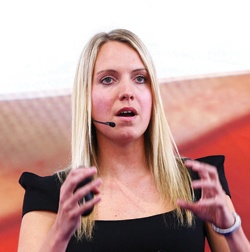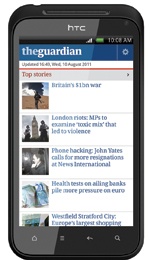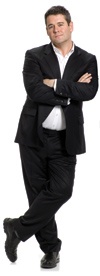Insider knowledge will deliver a winning deal
Knowing your customers was the big theme running through the advice on offer at Marketing Week Live. Michael Barnett rounds up the latest trends in tracking consumption habits and reveals why using those insights will leave you holding all the aces.

Do you know as much about your customer as you think you do? Are you as differentiated as you think you are? We certainly weren’t.” That is the admission of Caroline Harris, marketing director of Costa Enterprises - the division of the coffee company tasked with conceiving and executing new business ventures.
At Marketing Week Live, which hosted more than 13,000 visitors at Olympia in London over two days in late June, Harris described how Marketing Week’s 2011 brand of the year transformed itself into the UK’s leading coffee brand, with more stores than competitors Starbucks and Caffè Nero combined.
Costa Enterprises has continued this expansion with self-service machines and a range of home coffee making products stocked in supermarkets.
Costa found these new growth opportunities by first questioning what it really knew about itself as a brand. “Going back three or four years, we acted very much as a challenger brand. If we’re honest, we just wanted to follow Starbucks, and we rode the wave just following in their wake,” says Harris.
Last year, however, Costa’s overall sales grew by 24% and like-for-like sales by 5.5%, outperforming the market average by 6% each month, according to data from the British Retail Consortium. Yet overtaking its rivals doesn’t mean Costa has stopped seeking new insights into its business, which was what drove its changes in the first place. Today, Costa still receives over 40,000 responses a month on its customer feedback tool, internally branded Listen and Learn. It also has a “team engagement” survey called YourSay.

Costa: Overall sales grew by 24% last year and like-for-like sales increased by 5.5%
Indeed, if it hadn’t remained open to learning more about itself, Costa would have missed a fundamental change in how consumers choose their coffee brands, Harris says. “A year ago, convenience would have been the most important factor, but the quality of the coffee has now become the number one driver of preference.” Quality has duly been put at the centre of Costa’s marketing.
Costa is not the only brand that has been rethinking its own role as a business. When its worldwide sales more than trebled in two years between 2009 and 2011, mobile phone maker HTC was forced to reassess its position.
James Atkins, head of marketing for the UK and Ireland, says: “2010 was a golden year for sales, but 2011 exposed the challenges of HTC becoming a global brand.”
The marketing mission for HTC now, according to Atkins, is how do we shake off the small business mentality and how do we retain a level of consistency across all markets?
Rather than go with instinct, the business has taken a hard look at its own data to find the key to getting its phones into consumers’ hands. In the past, Atkins admits, that data might have been dismissed but the current strategy is to look at what it is saying and then act on it. Central to its current strategy is looking at how people actually buy mobile phones through recommendations by friends, family and experts in phone stores. Its latest global advertising campaign plays on this theme with its ‘as recommended by Nick Jojola’ commercial, showing the fashion photographer jumping out of a plane to test the functionality of the latest HTC One phone.
Adapt to change
Among the wide variety of speakers at Marketing Week Live - spanning seven categories from in-store to online, and representing every industry - the same topic arose repeatedly: the brands most able to adapt to change are those most willing to re-examine what they know about themselves and their customers, and to act on the insights they uncover.
British Airways head of revenue and customer analysis Jo Boswell says that the company’s newest customer service initiative, Know Me, was inspired by the idea of family businesses that know their customers personally and can deliver to their requirements without needing to ask. While it is impossible for a global airline to do the same, BA is making customer data available to its cabin crew and airport staff to help it achieve the next best thing (see case study below).
“Know Me is trying to replicate that feeling of walking into your favourite local restaurant, where you are recognised and made to feel special. But we need to do it in the airline environment, which is a very complex operation. Rather than having a fixed set of staff who are delivering that service and recognise those customers, we have thousands who deal with millions of customers,” Boswell says.
BA cabin crew and attendants on the ground use the Know Me system to identify passengers as they walk through the airport, or when they take their seats on the plane, and can address them personally and proactively. While other brands don’t go that far, the approach of finding out more about customers and feeding the information through to frontline staff is a trend that is growing among brands.

Live performance: Marketing Week Live put on demonstrations of the latest insight tools
TV and broadband provider Sky ensures operatives dealing with complaints, issues and enquiries have a comprehensive record of each individual customer that they can refer to. Hannah Graham, head of marketing at Sky IQ, the company’s customer intelligence division, says: “If you call a customer service centre, they should be able to see what channels you watch so they can tailor a package for you. Similarly, if an engineer comes round he should know what your last five problems were.”
But any insights a brand uncovers won’t remain relevant forever. The Guardian gave details at Marketing Week Live of how its online audiences have changed with the rise of mobile news, and Kraft revealed how new research into consumers in Germany showed the substantial impact price promotions had on sales of its Milka brand between 2010 and 2011 (see case studies).
It is not just in tracking consumption habits that brands can benefit from asking searching questions. There is just as much value in marketers asking whether the unchanging conventions of their market are really as inflexible as they seem. Challenging long-held assumptions can lead companies to conclude that what they believed to be universal truths were actually mind-forged manacles - artificial constraints holding them back from greater possibilities.
This led Lexus, the luxury arm of Toyota, to launch a new website that rejects the established template of car brand homepages, opting instead for a site that scrolls from one page to the next within the browser, featuring large images and little clutter in a similar style to the websites of luxury fashion brands.
European marketing communications head Chris Taylor demonstrated the new site at Marketing Week Live. Rather than adhering to the conventional wisdom that users should be directed through a ‘funnel’ from their arrival on the homepage through to making a purchase decision, Lexus gives visitors more liberty to roam around its site.

“Do you know as much about your customer as you think you do? Are you as differentiated as you think you are? We certainly weren’t” - Caroline Harris, Costa Enterprises
This ability to try out different options, particularly with the ‘scroll down’ page format, impacts positively on their completion of online tasks, such as comparing models, specifications and colours, Taylor claims.
He says the effects of breaking away from the hackneyed car website clichés have been dramatic. Compared with Lexus’s previous version, in the first three weeks after the new site went live in the UK there was a 75% decrease in the number of users who leave without viewing a second page.
There was also a 100% increase in the average length of visit, a 40-fold increase in views of key information such as car specifications and prices, and a 70% increase in use of Lexus’s online dealer locater tool, which is a good indicator that someone is considering a purchase or at least a test drive.
For a business to be able to ask the questions that create these changes, boardrooms need to ensure that there is a culture where enquiring minds are encouraged. As Barclays associate director of insight and analytics James Wycherley points out: “A lot of the skills needed to embed insight in a company are not specific to insight.”
A brand seeking more self-awareness doesn’t have to entrust the job to its research department alone. Wycherley says that Barclays encourages managers of individual branches to see themselves as “local chief executives”, taking a “helicopter view” of how every customer in that area views the company, and assuming responsibility for how the brand interacts with them on that level.
Wycherley and his colleagues will hope the retail bank’s approach to insight enables it to gauge consumer attitudes, and deal with the fallout from the Libor rate-fixing scandal that forced its chairman and chief executive to resign, quicker than it otherwise could. Like a growing number of marketers, he is empowering personnel to ask what they really know about their brand.
Case study: British Airways ‘Know Me’

Knowing your brand is about knowing your customers, and British Airways has recently taken a quantum leap in not just knowing them in great depth but also acting on the information in real time. Using iPads and even looking up passengers’ pictures on Google Images, BA is giving its staff the equipment to seek out passengers proactively and make an intervention - pointing them where they need to go or giving them an upgrade to first or business class, for example.
BA has just launched Know Me, a system that provides a single view of every customer and their history with the airline, which can be accessed on the move by service staff on planes and in airports. Senior staff now carry iPads that can bring up a seating plan for a specific BA flight, identifying where each customer is sitting, alongside relevant information such as what food they commonly order, whether they are loyalty scheme members and whether they have previously registered a complaint. BA has gathered all its data on customers from every service channel - the website, call centre, email, on board planes and inside airports - into one ‘data warehouse’, from where it can be used at any of those points of contact.
At Marketing Week Live, BA head of revenue and customer analysis Jo Boswell showed a video of service staff discussing their experiences with the new system. One had responded to a call about a customer trying to access the executive lounge, and although he wasn’t actually entitled to use it, he was allowed in as the staff member had identified previous service problems the customer had suffered.
The Know Me system also incorporates images that have been put online in the public domain, so staff can identify specific customers they need to find. Boswell says: “Our special services colleagues at Heathrow Terminal 5 were spending a lot of time on Google Images, trying to get a facial picture of the customer they were due to meet. We thought a simple thing would be to embed that functionality into the application. Once our colleagues have found that they can allocate the right picture to a name, that could then be eventually stored in the system for future use.”
The iPad system is not the only element of Know Me. Another is a system that returns pop-up messages to the consoles of check-in staff, prompting them to direct customers where they need to go.
BA plans a massive expansion of this programme during 2012, Boswell says: “Today we are delivering on average 320 of these personal recognition messages each day, but we have a bold ambition to get to 4,500 daily messages by the end of this year. That equates to about seven messages per flight. We are also planning to extend those to all registered customers, not just our frequent flyer members.”
BA will clearly have to be careful with its implementation of Know Me. While some customers will feel grateful for being lavished with extra attention, others might feel they are being spied on by staff. And if passengers learn that they can get a future upgrade by stocking up a couple of complaints on the BA database, it might encourage the wrong kind of behaviour.
But although BA doesn’t yet have results on how successful the initial implementation of Know Me has been, Boswell claims that market research during pre-launch trials showed improved satisfaction levels.
Case study: The Guardian - adapting to changing consumer habits

Changing media consumption habits are keeping The Guardian on its toes. Understanding where readers are consuming its news and features is key to understanding where its content needs to be.
The release of Apple’s iPhone came as an epiphany. As mobile business director Steve Wing told the audience at Marketing Week Live, it became palpable very quickly that more and more people were going to view the newspaper’s website on mobile devices. “It was, technically, one of those ‘oh shit’ moments, where you realise that everything has changed.”
The Guardian has learned much about the new digital habits of its mobile users. For example, between 60% and 70% of those using Guardian iPhone and iPad apps return to them several times a day - many more than its readers of other formats. “These are our brand advocates of the future,” Wing says.
For The Guardian, which is now a ‘digital first’ news organisation, separate editorial products have different audiences and objectives, even where they host many of the same articles. For example, Wing says the free-to-view website is a generalist ‘broadcast’ medium, while mobile apps, often paid-for, are more specialist ‘narrowcast’ vehicles.
The rise of mobile has been accompanied by a proliferation of media platforms across the web. The consequence is that media brands can no longer expect consumers to seek them out, but must have a presence anywhere that their users - and their competitors - are willing to venture.
“People expect to find The Guardian on Facebook, as much as they expect to find us on Google+, and as much as they expect to find us on YouTube. They will expect to find you at least in a mobile-optimised form,” says Wing.
News consumption is dominated by mobiles in the morning, while Facebook and Guardian.co.uk perform better at lunchtime, according to Wing. The Guardian is now working on how it needs to change its news operations in response.
“How do you commission your stories for different audiences at different times of the day? How do you schedule differently for the weekend if you’re not just talking about sport?” asks Wing.
Among The Guardian’s forthcoming product plans are an expansion of the number of apps aimed at specialist users, and the ability to make additional purchases within apps. But Wing admits that the additional money it expects to make from mobile products won’t replace that being lost from print advertising, judging by current estimates. “The amount of mobile ad revenue does not match the time people are spending there. That’s a big disjoint that needs fixing.”
The Guardian continues to lose more money every year, and is expected to announce a loss of £45m for the year to March 2012. Understanding consumer behaviour is key to its growth but it is a brand that still has some way to go to work out its place in the world of fragmented media.
Case study: Milka

What you don’t know about your brand will hurt you, as Kraft demonstrated when its Milka brand lost 15% of its sales volume in Germany between 2010 and 2011.
Kraft European analytics manager Matt Stockbridge told Marketing Week Live that media spend had increased substantially during the year, yet Milka had drastically underperformed compared with its competitors. Overall, German chocolate sales volumes fell by 4%, but Milka had done almost four times worse. “The reason the market declined by 4% was us. We screwed the market,” says Stockbridge.
The knee-jerk reaction was to blame a badly executed advertising campaign, but an analytical assessment of Milka’s sales data across the year and throughout Germany revealed findings that directly contradicted the initial hunch of an advertising failure.
Media spend, new product developments and sales promotions all had positive impacts on sales over 2011, driving increased purchases by volume compared with the previous year. In fact, advertising had the biggest positive impact on sales and without it, Stockbridge says, “we would have declined by 20%”. Where Milka had fallen down was on distribution, competition and price, all of which deterred consumers from buying its chocolate bars.
Each of these elements behind the decline could be blamed almost entirely on two price promotions that Milka had run in the previous year, but chosen not to repeat. They had been ditched because of the speed with which consumers had relieved retailers of their Milka stocks, destroying any profit margin for the manufacturer.
But in removing the promotions, Milka lost volume sales because the price did not seem as attractive to consumers, while negative sales impacts from distribution and competition arose because retailers gave the same promotional slots to other manufacturers, meaning those brands took market share from Milka.
Stockbridge says that Kraft learned important lessons about German consumers, who are the most price-sensitive in Europe. “If you run a promotion in the UK, you’ll usually attract the lighter users who will buy a single bar and won’t come back. If consumers in Germany see lower prices, they’ll buy 15 bars,” he says.
By investigating shopping habits rather than relying on just the top-line sales figures to tell the whole story, Kraft is now able to look at how to solve the very sticky issue of falling chocolate sales.
Mark Ritson’s seven rules of brand management

1. Remember your roots
“Strong brands come from people, places and times, and they remember it whether they are luxury brands or not,” says Ritson. Brands too often forget about or ignore their origins, and marketers in the English-speaking world are the guiltiest of it, he claims. Starbucks is one brand that lost its way, according to Ritson. He says: “The real problem with Starbucks is that it forgot its origins.” It took former chief executive Howard Schultz to return to the company to rediscover its roots.
All brands have a story of their founding: it describes why the business came into being. Most marketers don’t know how powerful theirs is.
2. Work out what’s in your brand’s DNA
A brand’s DNA should comprise just one strong concept and no more than five words that define how it behaves, according to Ritson. In luxury “it is defined by history and the consumer has no say in it”, he says.
But brand DNA is about walking the walk, not talking the talk, and it isn’t necessary to communicate explicitly what it’s made up of. People find George Clooney sexy for what he says and does, and for the way he looks, not because of the structure of his genes, Ritson points out. “Brands that have their words hanging up in the lobby are missing the point. If a consumer doesn’t repeat those things back to you verbatim, it’s not a problem.”
3. You can play with your codes
Codes are what make brands recognisable to their consumers - they are not just logos and they are not just visual, but they are motifs that the brand unmistakably owns, however they appear. Brands need to recognise that they can and must play with their codes to balance heritage with modernity - the constantly changing Google ‘doodle’ on the search engine’s homepage being an example.
This also means brands shouldn’t submit to “logo tyranny”, where marketers think the same typefaces, colours and proportions have to be rigidly repeated, says Ritson. “This is total bollocks. This is not branding. This is what people do when they don’t understand branding.”
4. Brands need to change to stay consistent
Ritson calls this the “paradox of time”. Brands make their name through the way they act at a particular point in time, but doing the same thing again and again will cease to have the same effect. The Dior fashion style that was provocative in 1950 had become tired by 2000, and it took John Galliano’s shocking ‘hobo chic’ collection, with dresses inspired by homeless people wrapped in newspapers, to restore Dior’s reputation as a disruptive brand.
5. No one hates vanilla, but no one loves it either
Being exclusive means excluding some people and welcoming others, and it is an important part of creating a brand. In luxury “it means you can engender passion in the higher segments and not give a toss about the mass market as a whole”, says Ritson. While non-luxury brands can’t afford to be as selective, Ritson says the principle holds true for all marketing.
“You have to believe first in segmentation and second in targeting. You can’t have a brand if you go for everyone. Marketing is not democracy,” he says.
6. Consumers don’t care what marketers say
At the most successful brands, senior executives stay silent, and don’t try to push their messages through mass media. Consumers “want to hear from the artisan”, Ritson says, so he advises letting the creators closest to the product explain their enthusiasm for it.
7. Your premium products power your brand
At a luxury brand, it is the couture fashions, the catwalk clothes, that define its image, like the star on the top of a Christmas tree. They are also the products that almost
no one buys, and overall they lose money. But Ritson says that marketers need to ask one question about their product lines: “What is the reason behind the product? Some products are there to make profit, others are there to build the brand.”









